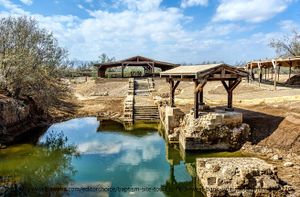Baptism Site of Jordan - Jordan: Difference between revisions
| Line 40: | Line 40: | ||
2. The site directly or tangibly associated with events or living traditions, with ideas, or with beliefs, with artistic and literary works of outstanding universal significance.'' | 2. The site directly or tangibly associated with events or living traditions, with ideas, or with beliefs, with artistic and literary works of outstanding universal significance.'' | ||
== | ==Why is this case relevant?== | ||
''The Baptism Site was chosen because it represents an evidence of what a society considers a “Holy place” and has been venerated as such since the Byzantine period, at least. It represents an example on how the geography, and Roman and Byzantine epochs have influenced the context. Nowadays, the site has a sensitive political challenge due to the shared waters with occupied Palestine “Israel”. | |||
The site gained its religious significance, because it is the location where Jesus of Nazareth was baptized by John the Baptist. The site also embraces two archaeological areas; The remnants of a monastery on a mound known as Tell Mar-Elias, and an area near the river with roman and byzantine remains of churches and caves used by hermits and pilgrims as dwellings and ponds in which baptisms were celebrated. And therefore, the site is inscribed in the UNESCO list of 2015. According to the UNESCO selection criteria, the site has gained its cultural significance because: | |||
1. The site bears a unique or at least exceptional testimony to a cultural tradition or to a civilization which is living or which has disappeared. | |||
2. The site directly or tangibly associated with events or living traditions, with ideas, or with beliefs, with artistic and literary works of outstanding universal significance.'' | |||
== Which challenges is this landscape facing?== | == Which challenges is this landscape facing?== | ||
Revision as of 16:10, 12 November 2018
>>>Back to Case Studies Overview
>>>Add here a title for your case
| Name | The Baptismal Site of Jesus Christ (Almaghtas) | |
| Place | Balqa governorate, Jordan Valley | |
| Country | Jordan | |
| Author(s) | Nawar H.Sabeeleish | |
| World Heritage | 2015 | |
|
| ||
The Baptism Site was chosen because it represents an evidence of what a society considers a “Holy place” and has been venerated as such since the Byzantine period, at least. It represents an example on how the geography, and Roman and Byzantine epochs have influenced the context. Nowadays, the site has a sensitive political challenge due to the shared waters with occupied Palestine “Israel”. The site gained its religious significance, because it is the location where Jesus of Nazareth was baptized by John the Baptist. The site also embraces two archaeological areas; The remnants of a monastery on a mound known as Tell Mar-Elias, and an area near the river with roman and byzantine remains of churches and caves used by hermits and pilgrims as dwellings and ponds in which baptisms were celebrated. And therefore, the site is inscribed in the UNESCO list of 2015. According to the UNESCO selection criteria, the site has gained its cultural significance because: 1. The site bears a unique or at least exceptional testimony to a cultural tradition or to a civilization which is living or which has disappeared. 2. The site directly or tangibly associated with events or living traditions, with ideas, or with beliefs, with artistic and literary works of outstanding universal significance.
Why is this case relevant?
The Baptism Site was chosen because it represents an evidence of what a society considers a “Holy place” and has been venerated as such since the Byzantine period, at least. It represents an example on how the geography, and Roman and Byzantine epochs have influenced the context. Nowadays, the site has a sensitive political challenge due to the shared waters with occupied Palestine “Israel”. The site gained its religious significance, because it is the location where Jesus of Nazareth was baptized by John the Baptist. The site also embraces two archaeological areas; The remnants of a monastery on a mound known as Tell Mar-Elias, and an area near the river with roman and byzantine remains of churches and caves used by hermits and pilgrims as dwellings and ponds in which baptisms were celebrated. And therefore, the site is inscribed in the UNESCO list of 2015. According to the UNESCO selection criteria, the site has gained its cultural significance because: 1. The site bears a unique or at least exceptional testimony to a cultural tradition or to a civilization which is living or which has disappeared. 2. The site directly or tangibly associated with events or living traditions, with ideas, or with beliefs, with artistic and literary works of outstanding universal significance.
Which challenges is this landscape facing?
- Here you discuss the types of negative impact you are observing but you can also mention new functions that could give a development opportunity
What would be your strategy for improvement?
Finally, please share some ideas of how you would initiate positive change for your heritage area
Image Gallery
- Yourimage.jpg
your image text and source
- Yourimage.jpg
your image text and source
- Yourimage.jpg
your image text and source
- Yourimage.jpg
your image text and source
- Yourimage.jpg
your image text and source
- Yourimage.jpg
your image text and source
- Yourimage.jpg
your image text and source
- Yourimage.jpg
your image text and source
References
- Author Year: Title, publisher, edition, page, ...
- etc.
- Website Year: Link, keyword, ...
- etc.
